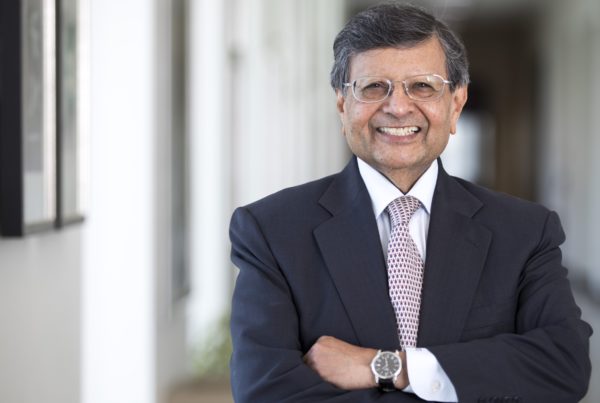Published: Nov 06, 2002 in Knowledge@Emory
With the possible exceptions of airlines and energy trading, no U.S. market sector today is in more turmoil than the telecom industry. Excess capacity, fierce competition, falling prices, staggering debt loads — all these factors, have come together to create a “perfect storm” for telecom providers.
During a panel discussion last month entitled “The Future of Telecom and The Latest Technology,” Jagdish Sheth, an industry consultant and professor of marketing at Emory University’s Goizueta Business School, and telecommunications analyst Jeff Kagan examined the besieged industry.
“In the 80s, the industry was driven by regulation, including the breakup of the Bell System and world-wide deregulation, privatization and competition. In the 90s, the industry was driven by technology and especially by the explosive growth of the Internet and consequent shift from voice to data traffic. Now in this decade, the industry is primarily driven by the capital markets, compromising of public equity, debt and private equity markets. Unfortunately, the public equity market has collapsed and the debt market has taken control of the industry,” explained Sheth.
Kagan, the author of Winning Communications Strategies, added a twist to Sheth’s telecom overview, “The [business] game of the 80s was leveraged buyouts. There’s been a new game in the 90s — stock options, where we thought we were going to mesh the interests of the CEOs with those of the shareholders,” Kagan observed. “But too many CEOs figured out ways of pumping up their stock price and then dumping it and getting out before anybody knew what was going on,” he continued. “They didn’t necessarily believe the stock would go crashing down, but they sure got out while the stock had excess value. It’s a game that has hurt us all.”
While he agrees with Sheth on the heavy influence of capital markets in the industry today, Kagan believes the telecom industry itself is robust and the outlook for the future is good.
“We all still need our telephones, we all still need our communications services,” Kagan noted. “Millions and millions of customers still send checks every month to telecom companies — they have a very healthy cash flow.”
Nonetheless, Sheth sees big financial problems for telecos. “As the debt ratio has gone up, management has lost control. In some cases, creditors are calling the shots — and what do they do? They typically have management shake-ups and they sell off assets. I expect to see more Chapter 11 filings: what happened to the dotcoms is now going to happen to more mature industries and companies,” Sheth warned.
Both experts agree that consolidation is inevitable. Yet it’s impossible to predict which brand names are going to survive. “One thing that’s clear is that we have too many competitors in the same space. We’re seeing a consolidation, a blending of all the different service types,” Kagan noted. “Now you can buy a local and long distance bundle from one company — say, BellSouth or AT&T or MCI –or from any one of eight different wireless companies, or from your cable company, or from other alternative providers.
“So all of a sudden, instead one or two to choose from, you’ve got 10 choices and that’s just too many. [Consumers] are going to want to choose only one of those companies, so the industry is setting itself up for a natural wave of consolidation, which is going to make telecom very robust five years from now. But we’re going to go through a lot of chaos during those five years.”
Indeed, the economy, the post 9/11 environment, and misguided strategies made in response to WorldCom’s financial postings and the Internet are also hurting the industry, Kagan said. “With WorldCom, the CEOs of every one of their competitors were trying so hard to match their numbers — they didn’t realize it was impossible, because those figures were the figments of someone’s imagination — but they restructured their companies in an effort to do that. And you had overbuilding [based on] the promise of the Internet doubling in usage annually. We really structured the moves we made in the last several years on myths — the price for that. The industry is going to get worse before it gets better.”
When asked whether the federal government would come to the telecom industry’s rescue, Sheth said, “I don’t think it will, because I don’t think the industry is in that bad of a shape.” Unlike the entrepreneurial “WorldComs” that entered the field later, the older players have a traditional corporate management structure that Sheth believes should serve them well. “Traditional telecos have a very strong industry culture about serving society, for example. I believe they’re financially smart in their own way. I don’t believe they’ll need to be bailed out by the government.”
Turning away from the woes of the industry, Kagan listed a number of positive advances. On the topic of video phones, for instance, he admits the industry has been promising their arrival since the 1960s, “So people don’t believe it any more.” In other words, broadband has got to become mainstream before video phones can be taken seriously again. Getting to that point, Kagan explained, “depends on when broadband reaches enough homes to entice the entrepreneurs and developers. Right now, there are roughly 10 million homes with broadband, but they’re scattered across the country and that’s just not enough of a marketplace to attract mass marketers. Once we get 30 or 40 million homes signed up, that’s when you have a real marketplace.
“The service providers say they have the ability to reach that many people right now … but the weak economy and job losses mean it’s just not a big priority for consumers, especially when broadband doesn’t deliver any new services — it just makes the Internet experience faster,” Kagan continued. “But as people spend more time on the Internet, and as applications grow more bandwidth intensive, it’ll drive them in frustration to broadband. I think over the course of the next three to four years, it could get up to that critical mass of 40 million homes.
People are going to love seeing their kids and grandkids — and telemarketers are going to love showing off their products and prize-winning vacations, too.”
Kagan sounded even more upbeat about the technologies beyond DSL and cable modems, including 3G, which is the term for third-generation wireless broadband. “Sprint just launched a 3G network; you’re always connected to the Internet, but the speed is at about dial-up speed [i.e., 56k]. People expected it to be faster right off the bat, but it’ll get there. And BellSouth is even running fiber optic lines into homes right now. Those [customers] think they’ve just got regular DSL, but BellSouth has the ability to greatly increase their data-flow speeds. Four years ago, I even saw a demonstration of cable TV coming over regular copper phone lines.”
The most prominent high-speed wireless technology today is called “Wi-Fi,” and according to Kagan, it’s being rapidly deployed in hotels, airports
— and even Starbucks.< "There’s a short-range transmitter that sits in the store and transmits in a radius that covers inside the store and a little bit beyond. So you can sit there with your laptop and -- with either a wireless card or the built-in antenna that new laptops now have -- you can pick up the transmitter’s signal, which gives you high-speed Internet access. You’re charged by how much you use, of course,” Kagan explained. This network of "hot spots" are being built around the country by T-Mobile/Deutsche Telekom and another Wi-Fi network is being built by a company called Boingo. “There’s a race now between them to build the most access points." Kagan ended with a piece of advice for small businesses dealing with telecom suppliers. "There are two trends that seem to be pulling in opposite directions: one is to bundle voice and data and everything together to get cost and service efficiencies, and that makes sense. On the other hand, because of 9/11, bankruptcies and all sorts of turmoil with service providers, there’s a fear of putting all your eggs in one basket. So diversifying in the name of business continuity and disaster preparedness also makes sense. If you don’t have back-up, if you don’t have redundancies, you could be out of business for weeks or even months -- which could actually put you out of business."




